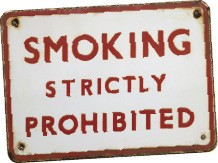Smokers are catching it from all sides.
They are banned from restaurants that admit children.
They are banished from the workplace to huddle on loading docks and
in outdoor areas to smoke in the cold, heat, and rain.
They are easy tax targets. Cigarette taxes were raised this year
from 18 cents to 68 cents a pack in Mississippi and from 62 cents to 67
cents a pack in Tennessee — less than New York’s $2.75 per pack
but more than North Carolina’s 35 cents a pack. In Memphis, a pack of
cigarettes costs from $3.50 to $6.
 Vonkara | Dreamstime.com
Vonkara | Dreamstime.com
Smokers are bombarded with remedies for quitting — from
hypnosis to Zyban and Chantix — and with public service ads that
say smoking is bad for their health.
Syndicated columnist George Will called them stupid.
In gentler language, they were called out by President Barack Obama,
who is himself trying to quit smoking. He recently signed a law
bringing tobacco products under federal control for the first time.
Smokers’ insurance costs are rising because smoking leads to
diseases such as lung cancer, emphysema, and heart disease that are
expensive to treat and drive up the cost of health benefits for all
employees.
And still they smoke. About 20 percent of Americans and 25 percent
of Tennesseans smoke, according to the American Cancer Society. And 90
percent of them begin on or before their 18th birthday. Smoking remains
popular among some college-educated Americans and even physicians, who
are well aware of the risks.
“I never worried about the health effects, and I still smoke and I
still don’t care,” said Memphian Greg Withrow, 29, an insurance claims
adjuster who started smoking at the age of 25 when he was in art school
in Scotland. “Everyone I was hanging out with started smoking at the
same time they’d just banned smoking in the clubs. At the time I
started, my plan was to die of lung cancer before graduating college so
I wouldn’t have to pay off my student loans. Unfortunately, that plan
didn’t work.”
Amy Dobbins, 26, said she started smoking two years ago when she was
at a bar on Beale Street with a friend.
“I started smoking because of stress and responsibilities,” she
said. “Now it keeps me mellow and from feeling awkward. I only smoke
when I’m stressed and drink. I go through, like, one pack in two
weeks.”
Obama focused on young smokers when he signed the Family Smoking
Prevention and Tobacco Control Act in June.
“They’re exposed to a constant and insidious barrage of advertising
where they live, where they learn, and where they play,” he said.
They’re also exposed to a lot of hypocrisy.
Obama’s smokers-as-victims statement downplays individual choice and
responsibility. The 80 percent of Americans who do not smoke or use
other tobacco products are exposed to the same temptations as those who
do.
The advertising “barrage” was much more intense a generation or two
ago, when cigarette companies were major sponsors of television
programs and famous athletes endorsed smoking. Two of the icons of
tobacco advertising have been dead for a decade or more. The Marlboro
Man, an American cowboy with a jut-jawed profile and a cigarette in his
mouth, was gone by 1999, along with some of the models that portrayed
him and died of lung disease. Joe Camel, a shades-wearing hipster
created to lure young smokers, met his demise in 1997. Camel, a brand
of the R.J. Reynolds Tobacco Company, has a new “smokeless, spitless”
product called Snus that comes in “frost” and “mellow” flavors.
 Meejahor | Dreamstime.com
Meejahor | Dreamstime.com
Omar Suboh
The president is not the only government official who is denouncing
smoking while indulging in its profits and pleasures. At both the state
and federal levels, government’s response to smoking is two-faced.
There may be no better example of this than Mississippi.
In 2008, Governor Haley Barbour, a former lobbyist for cigarette
makers, named a committee to study his state’s tax structure. It
recommended increasing the cigarette tax, then the third-lowest in the
country. In May, Mississippi increased its tax to 68 cents a pack.
Mississippi is famous for, among other things, its landmark
multi-billion-dollar settlement with Big Tobacco in 1997 to reimburse
the state for Medicaid funds. It is also a notoriously unhealthy state
with a disproportionate number of fat people, poor people, and people
with respiratory diseases. Its obesity rate, currently 32 percent, has
led the nation for five years.
Later this year, Mississippi state agencies will hold an unusual
auction. In April, a state and federal task force discovered thousands
of cases of contraband cigarettes — 30 truckloads by some
published reports — in a warehouse in Mississippi.
So what did Mississippi do with the bootleg cigarettes? Burn the
evil weed? Dump them in the Mississippi River? No, the Mississippi Tax
Commission will sell the contraband cigarettes to the highest bidder.
The sale could reap unpaid taxes of as much as $5 million, according to
the state auditor’s office. One state lawmaker rationalized the sale by
saying most of the brands ultimately will be sold in other states. Or
perhaps another country. America’s three leading exports are food,
weapons, and tobacco products.
 Rtimages | Dreamstime.com
Rtimages | Dreamstime.com
Dr. Robert Klesges
At the federal level, some people think smoking should be banned in
public housing projects, where exposure to second-hand smoke is
especially high.
“Children in densely populated public housing suffer the worst,”
wrote Dr. Jonathan Winickoff, chairman of the American Academy of
Pediatrics Tobacco Consortium, in a guest column in Newsweek
magazine recently.
The Department of Housing and Urban Development allows local public
housing authorities to make their buildings smoke-free but does not
require it. Robert Lipscomb, head of the City of Memphis Division of
Housing and Community Development, said there are no such restrictions
in Memphis.
“We’ve got to be careful about the rights of people and singling out
one class of people,” Lipscomb said. “We waste a lot of different
dollars on a lot of different things. This is a slippery slope. What
else do you control just because people are getting a subsidy?”
Lipscomb, a runner and nonsmoker, is not unmindful of the problem.
His mother and brother both died of lung cancer. He recalls his
mother’s death as “horrible,” but he also remembers her asking for a
cigarette when she was being rushed to the hospital.
What is it that makes smoking irresistible to 20 percent of the
American population?
In Tennessee, a tobacco-growing state with a tobacco leaf in its
state seal, 24 percent of the population smokes, including 84,000 high
school students who smoke or use smokeless tobacco, according to the
American Cancer Society.
 CandyBox | Dreamstime.com
CandyBox | Dreamstime.com
John Chiaramonte, director of government affairs for the American
Cancer Society in Tennessee, says peer pressure, rebellion against
parents, giveaways of tobacco products, and positive depictions of
smoking in movies, television, and photographs get young people
started.
In HBO’s Sex & the City, Carrie Bradshaw, played by
actress Sarah Jessica Parker, battled with her smoking habit. In
fashion designer Jean Paul Gaultier’s splashy fall show last year in
Paris, models traipsed up and down the runway carrying cigarettes in
stylish holders.
Chiaramonte predicts that banning candy and fruit-flavored
cigarettes, requiring larger and more graphic health warnings on
cigarette packs, and prohibiting marketing terms such as “light” and
“low tar” will further cut the smoking rate.
“The fact that 2 percent of the population has quit smoking in less
than two years is pretty significant,” he said.
The ban on smoking in public places and offices is not universal.
Tunica casinos and some Memphis bars and restaurants that limit
admission to those over age 21 remain bastions of smokers’ rights.
Indeed, nonsmokers can sometimes feel like they are in the minority at
watering holes like Zinnie’s or the P&H. Research studies say the
“congregating effect” reinforces smoking.
Harshit Shroff, 25, a recent graduate of Christian Brothers
University, knows the risks but has been smoking since 2003. He says it
relaxes him.
“It only harms people after a very long term, and I do not intend to
continue for long,” he said.

Shroff, who smokes three or four packs a week, said he has quit
before and could quit again if he wants to.
“I stopped for three months without any medication,” he said. “I
think quitting is more a matter of mentally being strong.”
Omar Suboh, 23, said he started smoking when he was 17 because “my
job sucked, and it gave me a reason to take a break at work.” He became
concerned about health risks two years ago when he started coughing up
phlegm when smoking. He tried to quit but still smokes three or four
cigarettes a week.
“Obviously, they are extremely addictive,” Suboh said. “But also, I
think, it’s partly because I didn’t practice self-control.”
Dr. Matthew Ninan is skeptical of an optimism that recalls Mark
Twain’s line that quitting smoking was easy because he had done it
hundreds of times. Ninan, who says he has been called “an anti-smoking
Nazi,” is a lung cancer and thoracic surgeon at the University of
Tennessee Health Science Center. Business is robust, and he expects it
to remain so for the next 20 to 30 years. Lung cancer is the biggest
cancer killer among both men and women.

“It is a daily challenge for me to work with people who have been
smoking for 30 or 40 years,” he said. “The vast majority of smokers
start when they are in school. Nicotine is a highly addictive
substance, and it becomes very difficult to quit. It is extremely
difficult even in the face of lung disease and heart disease.”
Ninan says some of his professional peers smoke.
“Certainly, smoking is not uncommon among physicians,” he said.
“Many of them are not daily smokers, but they do smoke cigars
recreationally.”
Ostracism of smokers goes too far in some cases and not far enough
in others, says Dr. Robert Klesges, a psychologist and professor of
preventive medicine at UTHSC. He says it makes no sense to ban smoking
in outdoor stadiums or within 30 feet of an airport terminal because
there is no danger from second-hand smoke in such an area. Hotels, on
the other hand, don’t go far enough. They advertise “non-smoking”
instead of “smoking” rooms, a subtle but important difference.

“The more you make it look like very few people are doing it, the
more you encourage people to quit,” he said.
The most effective bans create an environment where “it’s too big a
pain in the neck to smoke.”
Tobacco companies, Klesges says, are outstanding marketers, usually
staying one step ahead of anti-smoking efforts. A relatively new
product is called snus, advertised on the Camel SNUS website as being
“spitfree tobacco” that “can be enjoyed almost anywhere regardless of
the growing smoking bans and restrictions.” Advertising carries a
warning that “this product may cause gum disease and tooth loss.”
Klesges said that where snus has been introduced in the military, “they
can’t keep it on the shelves.”
Coupons for free samples of snus have been distributed in Memphis. A
Flyer nonsmoking intern tried it and described an initial
“burning” sensation that went away and left a pleasant “minty” taste.
Camel says the product delivers a “tingle.”
(Additional reporting by Bianca Phillips, Hannah Sayle, and Erica
Walters)
